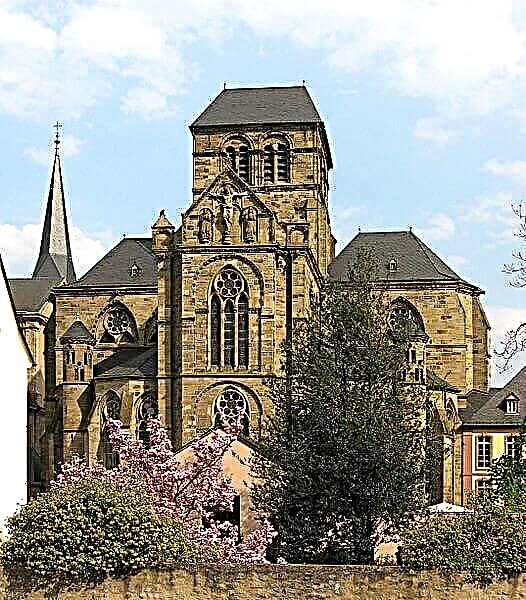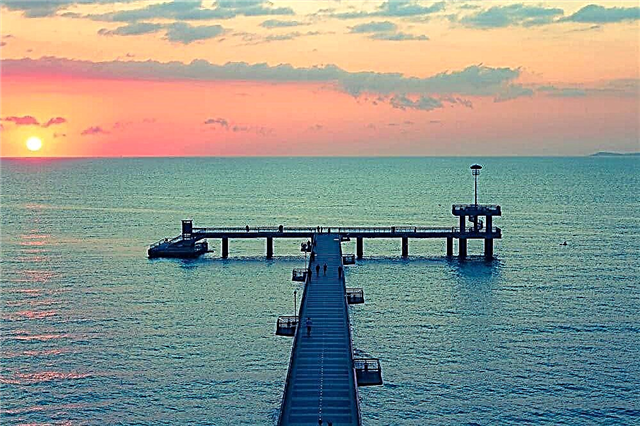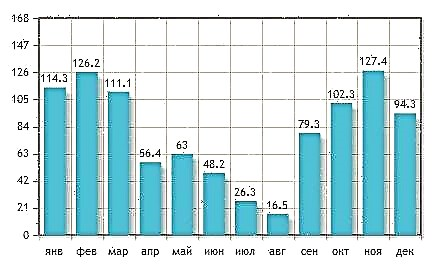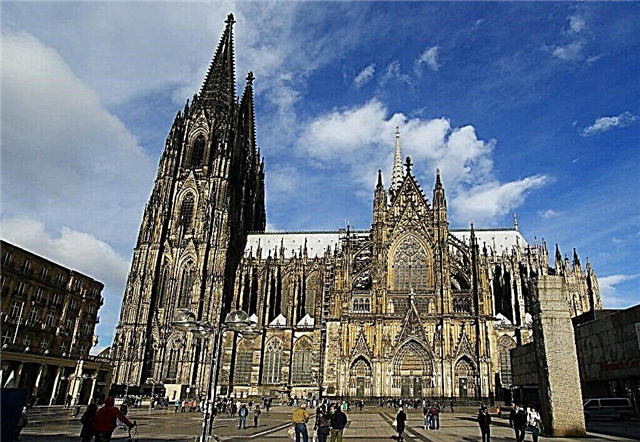The Gothic style covers different types of art - painting, fresco, sculpture, stained glass. But it is the medieval cathedrals, temples and monasteries of Europe, including Germany, that fully reveal the wealth, grandeur and monumentality of the Gothic style in architecture. It is characterized by the presence of narrow high towers, arches with a pointed top, multi-colored stained-glass windows on the windows, a lavishly decorated facade.
All this, together with the gloomy stone figures of mythical creatures on the walls of the buildings, creates an inimitable architectural ensemble. In the north of Germany, due to the shortage of natural stone, a special style was formed - brick Gothic, which significantly spread to the Baltic countries.
Cathedrals and monasteries of Germany in the Gothic style
Cologne Cathedral
One of the main masterpieces of Gothic architecture, whose towers rise to 157 meters, impresses with its monumentality and at the same time with the lightness and grace of its delicate forms. Having overcome 509 steps of the staircase, you can get to the bell tower, from where you can see the whole city and its surroundings. The cathedral contains valuable collections of paintings, jewelry, sculptures collected over the centuries. Among them are benches in the choir, frescoes, the main altar, stained-glass windows, crosses, monstrosities, etc.

Ulm cathedral
The construction of the second largest cathedral in Germany, which is still in operation, lasted 5 centuries. They began to build it in the XIV century, at the expense of the townspeople. And the western tower, 161 meters high, was completed only at the end of the 19th century. There is an observation deck on it; to get to it, you have to climb 768 steps. On the roof of the cathedral there is a sculpture of a sparrow - the symbol of the city of Ulm, with which a local legend is associated.

Frauenkirche (Munich)
The tallest cathedral in Munich was built in the 15th-16th centuries. Its original onion-domed towers are 99 meters high. Since the 16th century, representatives of the ruling dynasty of Bavaria have been crowned and buried in the cathedral. Despite the fact that during the war, most of the interior decoration of the temple was destroyed, the tomb of the Roman emperor Ludwig IV of black marble, a magnificent medieval altar, choral benches dating back to 1502 have survived.

Freiburg cathedral
The Cathedral in Freiburg was built in the XII-XVI centuries from red sandstone. A distinctive feature of its 116-meter tower is an openwork, transparent, like lace, spire. There are 16 bells in the tower, the oldest being 750 years old. There is also an observation deck at a level of 70 meters. The main decoration of the temple is the altar, painted with biblical scenes from the life of the Mother of God. The organ of the cathedral is one of the largest in the world.

Liebfrauenkirche (Trier)
One of the oldest Gothic churches in the world began construction in 1230 on the site of the palace of the mother of Emperor Constantine the Great. A covered gallery connects the church with the Trier Cathedral. The windows of the church are decorated with skilful stained-glass windows, its vaults are supported by 12 columns with images of 12 apostles. For a long time, the church was a burial place, but only a few tombstones and epitaphs have survived to this day.

Lubeck cathedral
The two-spire majestic building of the cathedral has a record length for red-brick churches - 130 meters. At the beginning of the 13th century, the cathedral was erected in the Romanesque style, and from 1266 it began to be rebuilt according to the laws of Gothic architecture. The pearls of the temple are the 17-meter-high Triumphal Cross and a pulpit with an astronomical clock, installed in 1477. Also, the attention of tourists is attracted by a number of stone sarcophagi in the funeral cathedral chapel.

Church of the Holy Spirit in Heidelberg
Construction of the largest temple in Heidelberg began in 1398 and lasted for over a hundred years. Here is the burial place of Elector Ruprecht III (founder of the church and city university) and his wife. Until 1623, several thousand unique books and manuscripts were kept within the walls of the church - the first copies of the Palatine Library, later taken to the Vatican. Nowadays, the church is active, it hosts services and concerts of organ music.

Magdeburg cathedral
One of the largest cathedrals in Germany was built over three centuries, starting in 1209. Its appearance combines Gothic and Romanesque features. The building is 120 meters long, the two towers are 99 and 104 meters high. The famous treasures of the temple are sculptures of virgins from the middle of the 13th century, ancient Roman granite and marble columns, carved figures on the theme of the life of Christ. Also on the territory of the cathedral there are numerous historical graves.

Church of St. Elizabeth in Marburg
The church is named after the wife of the Thuringian Landgrave, who founded a shelter for the poor in Marburg, caring for the sick and canonized after death. Her ashes are kept in the church in a golden sarcophagus. The magnificent stained-glass windows, frescoes, the altar of St. Elizabeth, wooden main altar of 1290, objects of applied art of the 13th-14th centuries. The church is crowned with two 80-meter towers with bells from the 13th century.

Regensburg Cathedral
The construction of the cathedral began in the 13th century and lasted for 6 centuries. Its treasury contains many Christian relics. Among them are the relics of John Chrysostom, Martyr Sebastian of Mediolan and Saint Lawrence, a bronze cross with rock crystal of the 12th century, a golden cross with precious stones from the 13th century, etc. Inside the temple are decorated with frescoes and stained-glass windows of the 14th century. The bell tower contains 8 bells, the oldest being 400 years old.

St. Nicholas Church in Stralsund
A gem of brick gothic. The church is dedicated to Nicholas of Mirlikisky - the famous patron saint of sailors, it was built from 1270 to 1360. The main decoration of the temple is a 12-meter carved altar, decorated with more than a hundred figures, a sculpture of St. Anne 2.5 meters high. Of particular value is a giant astronomical clock dating back to 1394 - one of the oldest in the world. Wall paintings and magnificent relief images are of no less interest.

Meissen Cathedral
The construction of the cathedral was carried out gradually and took a total of six and a half centuries. The cathedral is located on the territory of the Albrechtsburg castle; three openwork towers, which are visible from almost anywhere in the old city, give it a special sophistication. A true work of art is the main bell of the temple, cast in 1928. On its four sides are scenes from the apocalypse, and on top is a crown with 4 Evangelists.

Aachen Cathedral
One of the oldest temples in Europe, combining fragments of the classical, Byzantine and Gothic styles, was founded by Charlemagne in 796. For 6 centuries, German monarchs were crowned here. In the center of the cathedral there is an octahedral chapel, where the throne of Charlemagne is kept, and his remains rest in a golden sarcophagus. Among the Christian relics - the veil from the execution of John the Baptist, the loincloth of Christ, the veil of the Virgin Mary.

Frankfurt cathedral
The history of the temple dates back to the times of the Roman Empire, but its current appearance with Gothic features and a 100-meter red spire began to take shape in the 13th century. The cathedral is named after Saint Bartholomew, whose skull is the main shrine of the temple. The interiors are decorated with works of art, including a sculpture of the Crucifixion of Christ in 1509, a painting by Van Dyck "Descent from the Cross" in 1627, frescoes on the life of the Apostle Bartholomew in 1407.

Doberan monastery church
A striking example of brick gothic. At the beginning of the 12th century, the Doberan Monastery was built in Mecklenburg by the forces of Cistercian and lay monks. However, in the next two centuries, wars and fires destroyed the building.Only in 1368, the restoration work was completed, and the monastery church was consecrated, which became the main burial vault of the rulers of Mecklenburg. The monastery existed until the 16th century. Its building was restored several times, the last time in 1962.

Market Church in Hanover
The main Hanoverian church of red brick was built in the XIV century, the height of its tower with a spire is 98 meters. Medieval stained-glass windows from 1370, the main altar made of linden from 1480, and a bronze font from 1500 are valuable rarities. There are many church burials, mainly of the 16th-17th centuries. Another pride of the church is the bell tower of 11 bells. During the war, the church building was seriously damaged; the reconstruction ended in 1952.

Church of St. Lawrence in Nuremberg
One of the first churches in Germany to adopt the Lutheran faith at the beginning of the 16th century. Its main highlight is the magnificent openwork rosette of the window with a diameter of 10 meters between the two towers. The interiors are decorated with works of famous Nuremberg masters. The gilded candelabrum, tabernacle, stained-glass windows and sculptures are of great value. During the war, the church building was damaged, restoration work continued until the early 60s. The temple is active.

Church of St. Sebald in Nuremberg
The oldest church in Nuremberg is named after the missionary and patron saint of the city, whose relics are kept inside the temple. The construction of the church began in 1225 and continued for a century and a half. It has preserved magnificent sculptures, bas-reliefs, a Gothic medieval altar. The pride of the church was the organ of the mid-15th century - one of the oldest functioning organs in the world. Unfortunately, it was destroyed during the war and later replaced with a new instrument.

St. Mary's Church in Lubeck
The prototype of the brick Gothic style for dozens of churches in the Baltic region. Construction of the main parish church in the city began in 1251 and lasted 100 years. The height of its two towers with weather vane is 125 meters. There are 9 large and 10 small burial chapels in the church. The surviving relics include a bronze font from 1337, an altar from 1518, a relief with scenes of the Passion of Christ from 1515. In 1942 the church was badly damaged. The fallen and split bells are still kept in one of the chapels in memory of the bloody war.

Church of the Virgin Mary in Nuremberg
In 1358, the church was erected on the site of the demolished synagogue. Every day at noon, under the old 500-year-old clock located on the facade of the building, a real show begins with the participation of moving wooden figures - the emperor, electors, musicians. The most valuable thing inside the temple is an old altar by an unknown author, dating back to the 15th century. After significant destruction during the war, the church was restored several times.

Augsburg Cathedral
The majestic construction of the cathedral in Bavaria organically combines fragments of the Romanesque and later Gothic styles. Of great value are the world's oldest colored stained-glass windows depicting prophets and kings from the Old Testament. The period of their creation is the XI century. The wall frescoes of 1491, paintings and reliefs on the life of the Virgin Mary of 1493, the largest collection of tombstones with epitaphs in Germany have been perfectly preserved to this day.

Church of St. Lambert in Münster
The building of the temple in Münster was founded in 1375. Its 90-meter tower is the tallest in the city. According to a long-standing tradition, every evening the caretaker climbs it and blows the horn, thereby announcing that everything is calm in the area. The church is famous for the fact that after the collapse of the Münster commune in the 16th century, the bodies of three executed leaders of the uprising were exhibited here in iron cages. The cages are still suspended from the church tower.

Naumburg cathedral
The original cathedral with four towers was built in 1029 in the Romanesque style. And later, over the course of several centuries, it was expanded and completed in the Gothic style. The western choirs of the cathedral are known for their expressive and realistic stone figures by an unknown master of the 13th century. They are made in human height and depict 12 representatives of the highest nobility, on whose generous donations the temple was built.

St. Martin's Church in Landshut
The Gothic red brick temple in Landshut was built from 1389 to 1507 at the expense of wealthy citizens. Its tower is 130 meters high; for four centuries it was the tallest brick building in the world. To enjoy the panorama of the city, you need to climb 495 steps of the spiral staircase leading to the bell tower with 8 bells. Inside the temple there is a six-meter carved crucifix of Christ, made in 1495, an organ of the 18th century.

Schwerin Cathedral
One of the tallest brick Gothic buildings in northern Germany with a green spire visible from afar. The first mentions of the cathedral date back to the beginning of the 12th century. In the XIII century, priceless relics appeared here - a drop of Christ's blood in a stone and a thorn from the crown of thorns of Christ. And in the next century this collection was replenished with a fragment of the crucifixion of Jesus. The Triumphal Cross, a medieval altar, a bronze font, and an old organ are worthy of special attention.

Cathedral of St. Nicholas in Greifswald
Brick Gothic. The 100-meter octagonal tower of the cathedral is the symbol of the university city of Greifswald. There is an observation deck on it, to which 264 stone and about 100 more wooden steps lead. Also on the tower are 6 massive medieval bells. The construction of the cathedral began in the middle of the 13th century and continued until the beginning of the 15th century. Caspar David Friedrich, one of the famous German painters, was baptized in this temple in 1774.

Erfurt Cathedral
The Romanesque church, built in 1253, acquired its Gothic features in the middle of the 14th century. Its choir is decorated with 18-meter stained glass windows of the 15th century, which have no analogues in Germany. Inside the building, there are many works of medieval art, among them a bronze Wolfram candlestick from 1160, the height of a man. The special pride of the temple is the world's largest automatic bell, Gloriosa. It appeared on the tower in 1497 and is famous for its clear sound.

Bremen Cathedral
The foundation of the cathedral was laid in 1042, it acquired its final appearance with Gothic features in the 13th century and since then has been reconstructed only twice - in the 19th century and after the Second World War. The cathedral is decorated with two 100-meter openwork towers with a bell tower and an observation deck. The sights of the temple are the Lead cellar with mummies, the carved pulpit - a gift from the Swedish queen and the Biblical garden with plants mentioned in Scripture.

Corinne monastery
The now dilapidated red brick monastery is located on the shore of the lake a few kilometers from the town of Eberswald. It was built in the 13th century by the Cistercian monks. In the 16th century, the abbey was dissolved. Currently, it is an architectural monument of the brick Gothic style, actively visited by tourists; various cultural events are held in its preserved walls. In particular, the annual Corinne Summer Music Festival.

Lenin monastery
The Abbey at Kloster-Lenin near Potsdam was founded by Cistercian monks in 1180. It was located surrounded by forests and reservoirs, not far from the Monastyrskoye Lake. Its distinctive feature was the stingy architectural style of brick Romanic and Gothic, no frills, and a special technique for applying floral ornaments to stained-glass windows. One of the most prosperous monasteries lasted until 1542, and then was dissolved. Since the beginning of the 20th century, the building has belonged to the Convent of Louise Henrietta.












